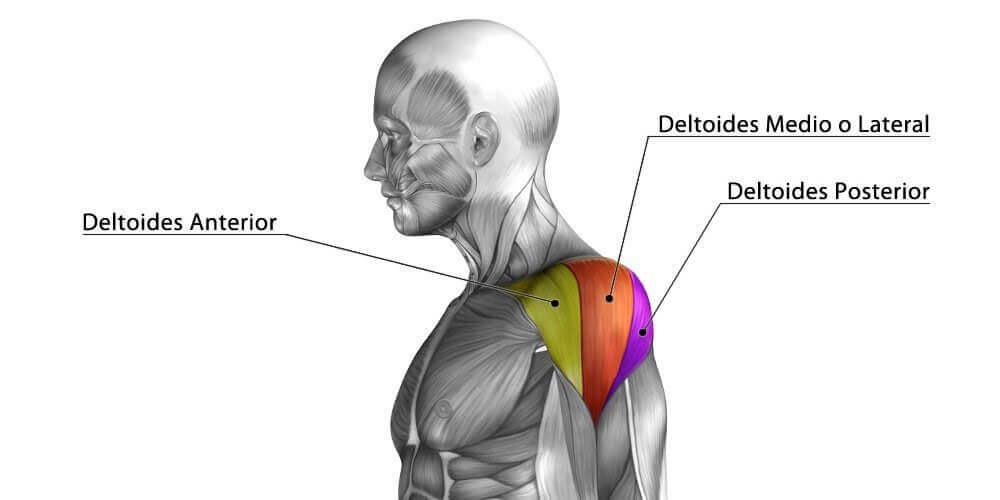Deltoid Muscle: Anatomy, Exercises and Stretches

The deltoid muscle is one of the most important muscles for anyone who exercises. It’s located in an area that’s crucial for movement regardless of the sport or exercise. Today, we want to explain the anatomy as well as some strengthening exercises and stretches. They’ll help you take care of your deltoid muscles and prevent injuries.
After reading our post, you’ll have no excuse not to take good care of this crucial area of your body.
Where is the deltoid muscle?
The deltoid muscle is located in the shoulder and covers it entirely. The triangular muscle was named after the similarly-shaped Greek letter Delta.
The deltoid muscles are directly involved in all of the movements you make with your shoulder. The main movements include flexing, extending and rotating.
Simply put, different fibers compose the deltoid muscle, organizing it into three groups:
- Clavicular fibers: cover the clavicle area and are in charge of raising the arm.
- Spinal fibers: located in the spine of the scapula. The spinal fibers are responsible for rotating the arm.
- Acromial fibers: these fibers arise from the superior surface of the scapula. They allow the arm to move away from the body.

Though it ultimately depends on the sport or exercise, the deltoid muscles undergo a lot of action. Because of how involved they are in movement, they’re vulnerable to injuries, pain or wear and tear.
Pain can appear in different forms as the muscle covers the entire shoulder area. However, the most common types of pain are lateral or frontal.
You need to strengthen these muscles and stretch them accordingly in order to prevent pain or injury. If you don’t know how to do this, check out our techniques below.
Deltoid strengthening exercises
After learning more about your deltoid muscle, you probably now understand why it’s so important to exercise it. We have a set of simple, yet highly effective exercises below. Make sure you follow our instructions carefully to avoid any kind of injury.
Dumbbell lifts
You only need a pair of medium-weights for dumbbell lifts. First, sit down against a wall. Sitting against a wall will help keep your back straight and prevent poor posture.
When you’re ready, grab your dumbbells and lift them slowly until they’re at the height of your chin. Make sure you raise them alongside your torso.

When they’re at the right height, you can start the second part of the exercise. Turn your hands outward as you lift the dumbbells over your head, completely extending your arms. Do sets of 10 reps and take 30-second breaks in between the sets.
Lateral Raise
Our next exercise is similar to the previous one. In fact, they also call for a pair of dumbbells. But this time, lift laterally. Lateral lifts will strengthen your delt zone.
Stand upright to start. Make sure you’re straight and firm; avoid moving back and forth during the entire exercise.
Grab a dumbbell in each hand and exhale as you lift them until the height of your shoulder. When you’ve lifted them to your shoulder, hold for three seconds.
After, return to the starting position. Dumbbells are very versatile and can work well for other similar exercises as well.

Different ways to stretch your deltoid muscles
Stretching is essential in any sport or exercise. Your deltoid muscles are no exception; they need a good stretch. Stretch by following our simple guidelines.
You can refer to our featured image to see a great way to stretch these muscles. Stretch out one arm and hold it down with the other to feel a light burn. This simple movement will completely stretch out your deltoid muscle and prevent many injuries.
Or, stretch out your arm on to a wall, making sure that your hand is diagonal and above your body while behind your body. Next, slowly twist your torso in the opposite direction to stretch out your deltoid muscle.
Lastly, if you practice a high-intensity sport or workout, or if you’re going going to use your deltoid muscle for an intense, prolonged exercise, repeat the stretch several times and hold the position for a few seconds.
The deltoid muscle is one of the most important muscles for anyone who exercises. It’s located in an area that’s crucial for movement regardless of the sport or exercise. Today, we want to explain the anatomy as well as some strengthening exercises and stretches. They’ll help you take care of your deltoid muscles and prevent injuries.
After reading our post, you’ll have no excuse not to take good care of this crucial area of your body.
Where is the deltoid muscle?
The deltoid muscle is located in the shoulder and covers it entirely. The triangular muscle was named after the similarly-shaped Greek letter Delta.
The deltoid muscles are directly involved in all of the movements you make with your shoulder. The main movements include flexing, extending and rotating.
Simply put, different fibers compose the deltoid muscle, organizing it into three groups:
- Clavicular fibers: cover the clavicle area and are in charge of raising the arm.
- Spinal fibers: located in the spine of the scapula. The spinal fibers are responsible for rotating the arm.
- Acromial fibers: these fibers arise from the superior surface of the scapula. They allow the arm to move away from the body.

Though it ultimately depends on the sport or exercise, the deltoid muscles undergo a lot of action. Because of how involved they are in movement, they’re vulnerable to injuries, pain or wear and tear.
Pain can appear in different forms as the muscle covers the entire shoulder area. However, the most common types of pain are lateral or frontal.
You need to strengthen these muscles and stretch them accordingly in order to prevent pain or injury. If you don’t know how to do this, check out our techniques below.
Deltoid strengthening exercises
After learning more about your deltoid muscle, you probably now understand why it’s so important to exercise it. We have a set of simple, yet highly effective exercises below. Make sure you follow our instructions carefully to avoid any kind of injury.
Dumbbell lifts
You only need a pair of medium-weights for dumbbell lifts. First, sit down against a wall. Sitting against a wall will help keep your back straight and prevent poor posture.
When you’re ready, grab your dumbbells and lift them slowly until they’re at the height of your chin. Make sure you raise them alongside your torso.

When they’re at the right height, you can start the second part of the exercise. Turn your hands outward as you lift the dumbbells over your head, completely extending your arms. Do sets of 10 reps and take 30-second breaks in between the sets.
Lateral Raise
Our next exercise is similar to the previous one. In fact, they also call for a pair of dumbbells. But this time, lift laterally. Lateral lifts will strengthen your delt zone.
Stand upright to start. Make sure you’re straight and firm; avoid moving back and forth during the entire exercise.
Grab a dumbbell in each hand and exhale as you lift them until the height of your shoulder. When you’ve lifted them to your shoulder, hold for three seconds.
After, return to the starting position. Dumbbells are very versatile and can work well for other similar exercises as well.

Different ways to stretch your deltoid muscles
Stretching is essential in any sport or exercise. Your deltoid muscles are no exception; they need a good stretch. Stretch by following our simple guidelines.
You can refer to our featured image to see a great way to stretch these muscles. Stretch out one arm and hold it down with the other to feel a light burn. This simple movement will completely stretch out your deltoid muscle and prevent many injuries.
Or, stretch out your arm on to a wall, making sure that your hand is diagonal and above your body while behind your body. Next, slowly twist your torso in the opposite direction to stretch out your deltoid muscle.
Lastly, if you practice a high-intensity sport or workout, or if you’re going going to use your deltoid muscle for an intense, prolonged exercise, repeat the stretch several times and hold the position for a few seconds.
All cited sources were thoroughly reviewed by our team to ensure their quality, reliability, currency, and validity. The bibliography of this article was considered reliable and of academic or scientific accuracy.
- Costa, Álex. Deltoides ‐ musculus deltoideus. Yoga Síntesis. http://www.cuerpomenteyespiritu.es/wp-content/uploads/2016/02/deltoides.pdf
- Ordax Giménez, G. (2001). Estiramientos. El Peu.
This text is provided for informational purposes only and does not replace consultation with a professional. If in doubt, consult your specialist.








